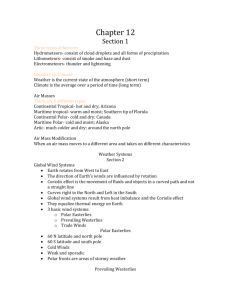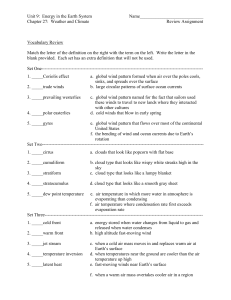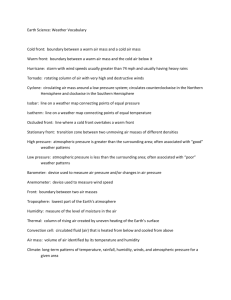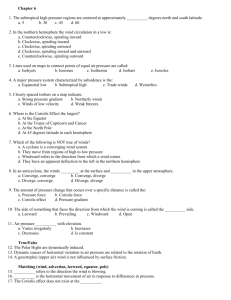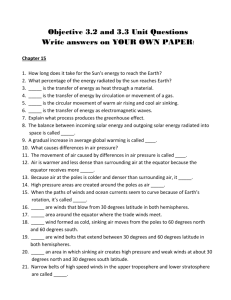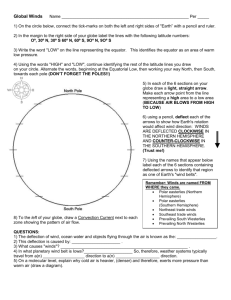Geog8.4 key
advertisement
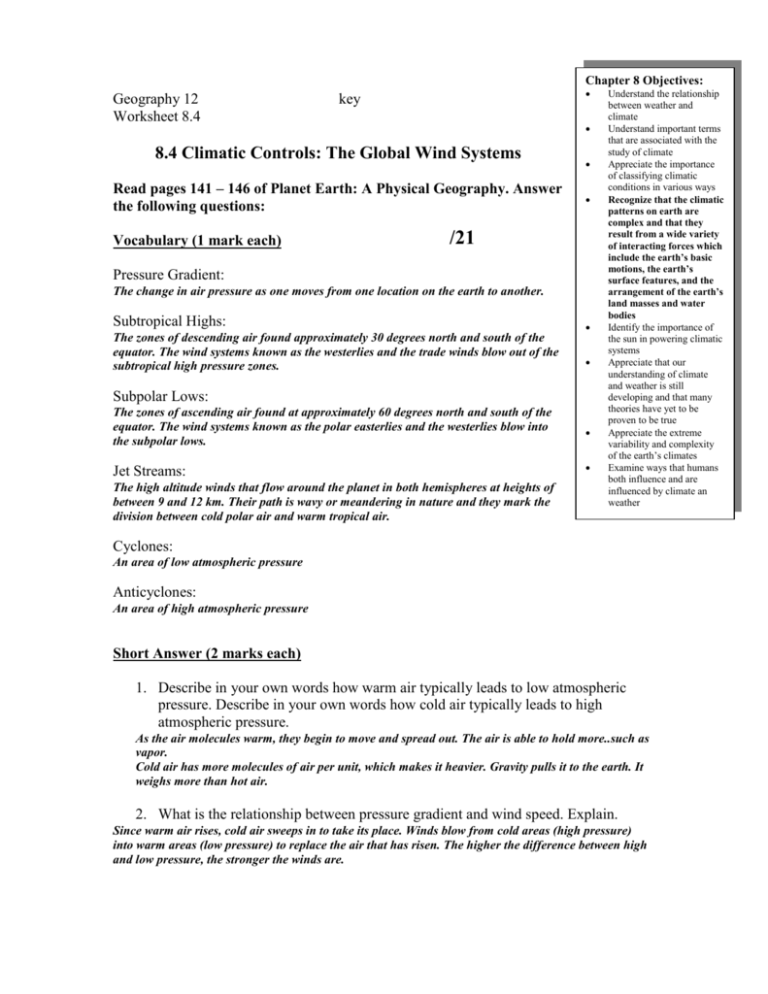
Chapter 8 Objectives: Geography 12 Worksheet 8.4 key 8.4 Climatic Controls: The Global Wind Systems Read pages 141 – 146 of Planet Earth: A Physical Geography. Answer the following questions: Vocabulary (1 mark each) /21 Pressure Gradient: The change in air pressure as one moves from one location on the earth to another. Subtropical Highs: The zones of descending air found approximately 30 degrees north and south of the equator. The wind systems known as the westerlies and the trade winds blow out of the subtropical high pressure zones. Subpolar Lows: The zones of ascending air found at approximately 60 degrees north and south of the equator. The wind systems known as the polar easterlies and the westerlies blow into the subpolar lows. Jet Streams: The high altitude winds that flow around the planet in both hemispheres at heights of between 9 and 12 km. Their path is wavy or meandering in nature and they mark the division between cold polar air and warm tropical air. Understand the relationship between weather and climate Understand important terms that are associated with the study of climate Appreciate the importance of classifying climatic conditions in various ways Recognize that the climatic patterns on earth are complex and that they result from a wide variety of interacting forces which include the earth’s basic motions, the earth’s surface features, and the arrangement of the earth’s land masses and water bodies Identify the importance of the sun in powering climatic systems Appreciate that our understanding of climate and weather is still developing and that many theories have yet to be proven to be true Appreciate the extreme variability and complexity of the earth’s climates Examine ways that humans both influence and are influenced by climate an weather Cyclones: An area of low atmospheric pressure Anticyclones: An area of high atmospheric pressure Short Answer (2 marks each) 1. Describe in your own words how warm air typically leads to low atmospheric pressure. Describe in your own words how cold air typically leads to high atmospheric pressure. As the air molecules warm, they begin to move and spread out. The air is able to hold more..such as vapor. Cold air has more molecules of air per unit, which makes it heavier. Gravity pulls it to the earth. It weighs more than hot air. 2. What is the relationship between pressure gradient and wind speed. Explain. Since warm air rises, cold air sweeps in to take its place. Winds blow from cold areas (high pressure) into warm areas (low pressure) to replace the air that has risen. The higher the difference between high and low pressure, the stronger the winds are. 3. Briefly explain how the Coriolis Force effects global winds? Due to the spinning of the earth, the atmospheric winds are deflected to the right in the Northern Hemisphere and to the left in the Southern Hemisphere 4. Briefly explain what causes subtropical highs. As the heated air from the equator rising meets the colder air from the poles, the cold air being heavier rapidly sinks to the earth. The areas of high pressure (heavier, dense air descending to the earth) are called subtropical highs. They are found approximately at 30 degrees north and south of the equator. 5. Briefly explain what causes subpolar lows. Some of the air descending at the subtropical high is flows towards the equator (trade winds) and some flows towards the poles (westerly winds). As the westerlies flow towards the poles, they meet the winds flowing towards the equator (high pressure zones). When these two surface wind systems meet, the warm air is forced upward. We call this zone of low pressure the subpolar lows. 6. What is the jet stream and what two ways does it affect our weather? (3 marks) The jet stream is a high-altitude wind that divides the cold polar air and the warm tropical air. 1. The waves in the jet stream help develop the low pressure systems and the high pressure systems that dominate the weather (storms or sunshine). 2. The jet stream also seems to be the process by which surplus energy in the equatorial regions is moved to the poles. 7. What is the prevailing wind in Golden, BC? Why? Westerly. We live in the area north of the 30 parallel (50 degrees north) in which the westerlies blow.
